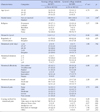Abstract
Purpose
The purpose of this study was to compare the premenstrual syndrome (PMS) and the relationships among PMS, perfection, and anxiety in nursing college students and general college students.
Methods
The questionnaire survey was carried out with a convenience sample of 215 college students. The MDQ (Menstrual Distress Questionnaire), APS-R (Almost Perfect Scale-Revised), STAI (State and Trait Anxiety Inventory) were used. The data were collected from June to October, 2011. Data analysis included frequency, χ2-test, t-test, and Pearson correlation.
Results
There were significant differences in PMS and perfection but there not in anxiety between nursing college students and general college students. There were significant correlations among PMS, perfection and anxiety in nursing college students, and there were significant correlations among PMS and anxiety in general college students but not significant correlations among PMS and perfection.
Figures and Tables
References
1. Ahn HY, Hyun HJ, Kim HW. Premenstrual discomforts and coping in university students. J Korean Acad Community Health Nurs. 2005; 16:289–299.
2. Ahn JY. Study on the co-relation between anxiety and english learning proficiency. Cheonan: Hoseo University;2002. Unpublished doctoral dissertation.
3. Premenstrual syndrome. American College of Obstetricians and Gynecologists;2011. Retrieved July 23, 2013. from http://www.acog.org/~/media/For%20Patients/faq057.pdf?dmc=1&ts=20130723T0306209427.htm.
4. Cho JH, Kim DI, Park KB, Kang HC. The correlation analysis of factors related to PMS through survey. J Orient Obstet Gynecol. 2006; 19:174–204.
5. Cho KS. The relationships among premenstrual syndrome, automatic thought, and perfectionism of collegewomen students. Korean J Adult Nurs. 2002; 14:144–153.
6. Choi DS. The diagnosis and management of premenstrual syndrome, premenstrual dysphoric disorder. In : The 41th training workshop for Korean Society of Obstetrics and Gynecology; Seoul: The Korean Association of Obstetricians and Gynecologists Press;2009. 41:p. 135–146.
7. Chung MK. A study on the menstrual knowledge, attitudes, symptoms and coping of the high school girls. Seoul: Ewha Womans University;1999. Unpublished master's thesis.
8. Cohen J. tatistical power analysis for the behavioral sciences. 2nd ed. New Jersey: Lawrence Erlbaum Associates;1988.
9. Hong KJ, Park YS, Kim JE, Kim HW. Study on the effects of the nursing intervention program for perimenstrual discomfort of the female university students. J Korean Acad Nurs. 1998; 28:821–831.

10. Jeong KA. Premenstrual syndrome (PMS): Clinical approach of diagnosis and treatment. Korean J Obstet Gynecol. 2007; 50:416–422.
11. Jun EM. A study on menstrual symptoms, coping and relief of symptoms in female college students. Korean J Women Health Nurs. 2003; 9:161–169.

12. Kim HW. The effects of a PMS nutritional education program for college students. J Korean Acad Nurs. 2006; 36:1164–1174.

13. Kim HW. Relationships between sex role identity, health promoting behaviors, and premenstrual symptoms among female university students. J Korean Acad Nurs. 2007; 37:1003–1012.

14. Kim HW, Khil JM. A study on isoflavones intake from soy foods and premenstrual symptoms. J Korean Acad Nurs. 2007; 37:276–285.
15. Kim JE. College women students' attitude toward menstruation, preception of sex role and pre and postmenstrual discomfort. Korean J Matern Child Health Nurs. 1992; 2:55–69.
16. Kim MJ, Nam YS, Oh KS, Lee CM. Some important factors associated with premenstrual syndrome: Influence of exercise, menarche, and age on PMS. Korean J Growth Dev. 2003; 11:13–26.
17. Kim SY. A study of the relationships between perfectionism tendency, depression, and self-esteem of the undergraduate students: Focused on th APS-R (the Almost Perfectionism Scales-Revised). Seoul: Yonsei University;2005. Unpublished master's thesis.
18. Kim YH, Lee IS. A study on the dysmenorrhea in college female students. Korean J Women Health Nurs. 2002; 8:85–95.

19. Lane T, Francis A. Premenstrual symptomatology, locus of control, anxiety and depression in women with normal menstrual cycles. Arch Womens Ment Health. 2003; 6:127–138.

20. Lee SH, Kim KJ. Menstrual characteristics and premenstrual syndromes. Chonbuk Univ Med J. 1989; 13:181–191.
21. Lim HS, Park YS. Differences in dietary intake and life-style of female college students in Seoul with and without premenstrual syndrome. J Korean Soc Menopause. 2010; 16:153–161.
22. Moos RH. The development of a menstrual distress questionnaire. Psychosom Med. 1968; 30:853–876.

23. Park HE, Jee BC, Ku SY, Suh CS, Kim SH, Choi YM, et al. A survey on premenstrual syndrome. Korean J Obstet Gynecol. 2005; 48:401–410.
24. Park JW, Kim JS, Lee KY, Park TJ, Kim SH. Factors associated with premenstrual syndrome in highschool students. Korean J Fam Med. 2009; 30:710–716. http://dx.doi.org/10.4082/kjfm.2009.30.9.710.
25. Shin MA. A structural model of premenstrual Symptom in female college students. Seoul: Hanyang University;2005. Unpublished doctoral dissertation.
26. Shin MA, Jeong MH. The relationship between premenstrual syndrome and sex role of college students. J Korean Acad Community Health Nurs. 2006a; 17:125–133.
27. Shin MA, Jeong MH. The relationship between premenstrual syndrome and menstrual attitudes of college students. J Korean Acad Soc Nurs Educ. 2006b; 12:43–51.
28. Slaney RB, Rice KG, Mobley M, Trippi J, Ashby JS. The almost perfect scale-revised. Meas Eval Couns Dev. 2001; 34:130–145.
29. Son YJ, You MA. Relationships between psychological factors and premenstrual syndrome symptoms in academic female high school. Korean J Health Promot Dis Prev. 2008; 8:8–16. http://dx.doi.org/10.4082/kjfm.2009.30.9.710.
30. Song JE, Chae HJ, Jang WH, Park YH, Lee KE, Lee SH, et al. The relationship between life style, menstrual attitude and premenstrual syndrome in nursing students. Korean J Women Health Nurs. 2013; 19:119–128. http://dx.doi.org/10.4069/kjwhn.2013.19.2.119.

31. Spielberger CD. Manual for the state-trait anxiety inventory (STAI-form Y). CA: Consulting Psychologists Press;1983.
32. Winer SA, Rapkin AJ. Premenstrual disorders: Prevalence, etiology and impact. J Reprod Med. 2006; 51:339–347.




 PDF
PDF ePub
ePub Citation
Citation Print
Print







 XML Download
XML Download